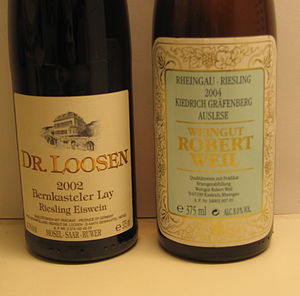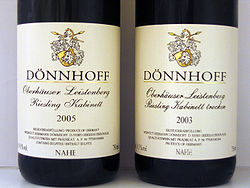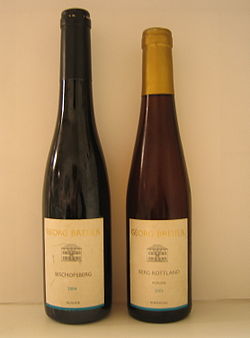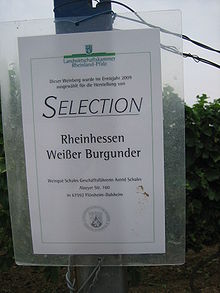- German wine classification
-
 Bottles from two of Germany's top producers showing the various pieces of information that can be found on a German wine label.
Bottles from two of Germany's top producers showing the various pieces of information that can be found on a German wine label.
The bottle on the left displays information in the following order: Producer (Dr. Loosen) - vintage - village (Bernkastel) and vineyard (Lay) - variety (Riesling) and Prädikat (Eiswein) - mandatory information in small print - alcoholic strength, region (Mosel-Saar-Ruwer) and volume.
The bottle on the right uses a slightly different order: Region (Rheingau) and variety (Riesling) - vintage - village (Kiedrich) and vineyard (Gräfenberg) - Prädikat (Auslese) - producer (Weingut Robert Weil) - volume and alcoholic strength.German wine classification consists of several quality categories and is often the source of some confusion, especially among non-German speaking wine consumers. The official classification is set down in the wine law of 1971, although some changes and amendments have been made since then. The classification is based on several factors, including region of origin, whether sugar has been added, and the ripeness of the grapes. The system is quite different from the French Appellation d'Origine Contrôlée system, or the systems in most other countries. In addition, German wine labels can be confusing for non-German speakers, although they give much information to those who are able to read them.
In recent years, the official classification has been criticised by many of the top producers, and additional classifications have been set down by wine growers' organisations such as VDP, without enjoying legal protection. The two main reasons for criticism are that the official classification does not differentiate between better and lesser vineyards and that the quality levels are less appropriate to high-quality dry wines.[1]
Contents
Overview of categories
Two of the basic parameters in the classification of German wines are sweetness and quality. Wine quality is to some extent a subjective judgement, and within the framework of any formal wine classification, different producers achieve very different results. However, the different quality categories used in classification of German wines are to some extent related to varying wine-making practices that generally are associated with different levels of quality:
- The EU category "quality wines" is by definition supposed to be superior to the category "table wines".
- A category that allows chaptalization is generally inferior to a category that does not allow chaptalization, if wines that are "true to terroir" are to be produced.
- A category that may only be produced in certain vineyard sites is generally superior to a category which may be produced anywhere.
- A category that requires the grapes or the wine to fulfill quality criteria (e.g. ripeness of the grapes) that are so stringent that they can not be met by most vineyard sites in most vintages, can also be considered superior to categories which can be produced from almost any vineyard in almost any vintage.
Applying these distinctions to the categories in German wine classification gives the following overview. The table is primarily drawn up with wines produced from riesling grapes in mind.
-
Sweetness Indicative sugar level Typical quality level grams per liter Low Medium Medium to high High Chaptalization allowed Chaptalization not allowed Table wine (EU) Quality wine (EU) From any vineyard
in any vintageOnly from classified vineyards
or
Usually not possible to produce
in any vineyard in any vintageIntensely sweet >150,
sometimes >200Trockenbeerenauslese
(Eiswein)Sweet 100-150 Eiswein
Beerenauslese
Auslese
(Especially if Goldkapsel or ***
has been added)Semi-sweet 30-60 Tafelwein QbA
LiebfraumilchSpätlese
KabinettAuslese
(Especially from Mosel)
Erste Lage Spätlese
Erste Lage KabinettOff-dry
Can taste "internationally dry"
if the acid level is sufficient10-20 Tafelwein
LandweinQbA feinherb
QbA halbtrocken
ClassicSpätlese feinherb
Kabinett feinherb
Spätlese halbtrocken
Kabinett halbtrockenAuslese feinherb
Auslese halbtrocken
ChartaDry 0-9 Landwein QbA trocken
ClassicSpätlese trocken
Kabinett trockenGrosses Gewächs
Erstes Gewächs
Erste Lage QbA
Selection
Auslese trocken
Quality categories
The 1971 German wine law defines four overall quality categories:[2]
- Deutscher Tafelwein, or 'German table wine'
- This is the equivalent to vin de table. It must be produced exclusively from allowed German-grown grape varieties in one of the five Tafelwein regions. Region or subregion must be indicated on the label. The grapes must reach a must weight of 44°Oe on the Oechsle scale (5% potential alcohol) in most regions, with the exception of Baden where 50°Oe (6% potential alcohol) must be reached. The alcohol content of the wine must be at least 8.5% by volume, and concentration or chaptalization can be used to reach this level. They must reach a total acidity of at least 4.5 grams/liter. Tafelwein (without "Deutscher") can be a so-called Euroblend, a table wine made from grapes grown in several European countries.
- Deutscher Landwein, or 'German country wine'
- This is the equivalent to vin de pays, and was introduced with the 1982 harvest. Regulations are similar to those for Deutscher Tafelwein, but must come from one of the 19 Landwein regions, the grapes must reach 0.5% higher potential alcohol, and the wine must be dry (trocken) or off-dry (halbtrocken) in style, i.e. may not be semi-sweet. "Landwein" can also refer to German fruit wines.
- Qualitätswein bestimmter Anbaugebiete (QbA), or quality wine from a specific region.
- These wines must be produced exclusively from allowed varieties in one of the 13 wine-growing regions (Anbaugebiete), and the region must be shown on the label. The grapes must reach a must weight of 51°Oe to 72°Oe depending on region and grape variety. The alcohol content of the wine must be at least 7% by volume, and chaptalization is allowed. QbA range from dry to semi-sweet, and the style is often indicated on the label. There are some special wine types which are considered as special forms of QbA. Some top-level dry wines are officially QbA although they would qualify as Prädikatswein. It should be noted that only Qualitätswein plus the name of the region, rather than the full term Qualitätswein bestimmter Anbaugebiete is found on the label.
- Prädikatswein, recently (August 1, 2007) renamed from Qualitätswein mit Prädikat (QmP) (superior quality wine)
- The top level of the classification system. These prominently display a Prädikat from Kabinett to Trockenbeerenauslese on the label and may not be chaptalized. Prädikatswein range from dry to intensely sweet, but unless it is specifically indicated that the wine is dry or off-dry, these wines always contain a noticeable amount of residual sugar. Prädikatswein must be produced from allowed varieties in one of the 39 subregions (Bereich) of one of the 13 wine-growing regions, although it is the region rather than the subregion which is mandatory information on the label. (Some of the smaller regions, such as Rheingau, consist of only one subregion.) The required must weight is defined by the Prädikat, and the alcohol content of the wine must be at least 7% by volume for Kabinett to Auslese, and 5.5% by volume for Beerenauslese, Eiswein and Trockenbeerenauslese.
Under the European Union wine quality grouping, Tafelwein and Landwein belong to the group of table wines, while QbA and Prädikatswein belong to the group of quality wines or VQPRD (Vin de qualité produit dans une région déterminée). In 2005, Tafelwein and Landwein only accounted for 3,6% of total production, QbA 49,6% and Prädikatwein (then called QmP) 46,8%.[3] In most European countries, table wines make up a much higher proportion of the total production. While there are many German wines of excellent quality, the difference in comparison to other countries lies more in the national wine law and how it is applied by the growers. A case in point is Liebfraumilch, which foreign wine drinkers often see as the "simplest" German wine, but which is considered to be a special form of QbA and therefore a quality wine.
Prädikat designations
The Prädikatswein (formerly QmP) category of the classification contains most high-quality German wines, with the exception of some top-quality dry wines. The different Prädikat designations differ in terms of the required must weight, the sugar content of the grape juice, and the level required is dependent on grape variety and wine-growing region and is defined in terms of the Oechsle scale. In fact the must weight is seen as a rough indicator of quality (and price). The Prädikat system has its origin at Schloss Johannisberg in Rheingau, where the first Spätlese was produced in 1775[4] where wines received different colour seals based on their must weight.
The different Prädikat (superior quality wine) designations used are as followed, in order of increasing sugar levels in the must:
- Kabinett
- fully ripened light wines from the main harvest, typically semi-sweet with crisp acidity, but can be dry if designated so.
- Spätlese - meaning "late harvest"
- typically semi-sweet, often (but not always) sweeter and fruitier than Kabinett. Spätlese can be a relatively full-bodied dry wine if designated so. While Spätlese means late harvest the wine is not as sweet as a dessert wine.
- Auslese - meaning "select harvest"
- made from selected very ripe bunches or grapes, typically semi-sweet or sweet, sometimes with some noble rot character. Sometimes Auslese is also made into a powerful dry wine, but the designation Auslese trocken has been discouraged after the introduction of Grosses Gewächs. Auslese is the Prädikat which covers the widest range of wine styles, and can be a dessert wine.
- Beerenauslese - meaning "select berry harvest"
- made from individually selected overripe grapes often affected by noble rot, making rich sweet dessert wine.
- Eiswein (ice wine)
- made from grapes that have been naturally frozen on the vine, making a very concentrated wine. Must reach at least the same level of sugar content in the must as a Beerenauslese. The most classic Eiswein style is to use only grapes that are not affected by noble rot. Until the 1980s, the Eiswein designation was used in conjunction with another Prädikat (which indicated the ripeness level of the grapes before they had frozen), but is now considered a Prädikat of its own.
- Trockenbeerenauslese - meaning "select dry berry harvest" or "dry berry selection"
- made from selected overripe shrivelled grapes often affected by noble rot making extremely rich sweet wines.
The minimum must weight requirements for the different Prädikat designations are as follows.[5] Many producers, especially top-level producers, exceed the minimum requirements by a wide margin.
-
Prädikat Minimum must weight Examples of requirements Minimum alcohol level in the wine Dependent on grape variety and wine-growing region Riesling from Mosel Riesling from Rheingau Kabinett 67-82°Oe 70°Oe 73°Oe 7% Spätlese 76-90°Oe 76°Oe 85°Oe 7% Auslese 83-100°Oe 83°Oe 95°Oe 7% Beerenauslese, Eiswein 110-128°Oe 110°Oe 125°Oe 5.5% Trockenbeerenauslese 150-154°Oe 150°Oe 150°Oe 5.5%
This does not necessarily determine the sweetness of the final wine, because the winemaker may choose to ferment the wine fully or let some residual sugar remain.
Additional designations
Wines can bear additional designation based on their sugar content or color.
Sweetness of the wine
The sugar content in the finished wine can be indicated by the following designations for QbA and Prädikatswein.[6] For sparkling wines (Sekt), many of the same designations are used, but have a different meaning.
-
Designation English translation Maximum sugar level allowed Low acid wines Medium acid wines High acid wines trocken dry 4 grams per liter acid level in grams per liter + 2 9 grams per liter halbtrocken half-dry 12 grams per liter acid level in grams per liter + 10 18 grams per liter feinherb off-dry Unregulated designation, slightly sweeter than halbtrocken lieblich, mild or restsüß semi-sweet Usually not specially marked as such on the label.
Follows by default from their Prädikat in the absence of the above designations.süß or edelsüß sweet Usually not specially marked as such on the label.
Follows by default from their Prädikat in the absence of the above designations.
Color
There are also color designations that can be used on the label:[7]
- Weißwein - white wine
- May be produced only from white varieties. This designation is seldom used.
- Rotwein - red wine
- May be produced only from red varieties with sufficient maceration to make the wine red. Sometimes used for clarification if the producer also makes rosés from the same grape variety.
- Roséwein - rosé wine
- Produced from red varieties with a shorter maceration, the wine must have pale red or clear red color.
- Weißherbst - rosé wine or blanc de noirs
- A rosé wine which must conform to special rules: must be QbA or Prädikatswein, single variety and be labelled with the varietal name. There are no restrictions as to the color of the wine, so they range from pale gold to deep pink. Weißherbst wines also range from dry to sweet, such as rosé Eiswein from Spätburgunder.
Extra ripeness or higher quality
Some producers also use additional designations to denote quality or ripeness level within a Prädikat. Especially for Auslese, which can cover a wide range of sweetness levels, the presence of any of these designations tends to indicate a sweet dessert wine rather than a semi-sweet wine. These designations are all unregulated.
- Goldkapsel - gold capsule
- A golden capsule or foil on the bottle. Denotes a wine considered better by the producer. Usually means a Prädikatswein that is sweeter or more intense, or indicates an auction wine made in a very small lot.
- Stars *, ** or ***
- Usually means that a Prädikatswein has been harvested at a higher level of ripeness than the minimum required, and can mean that the wine is sweeter or more intense.
- Fuder (vat) numbers
- Usually indicated for better wines and often the numbers are arranged in some logical order, although the same numbers need not return in each vintage. This practice seems to be most common for semi-sweet and sweet wines in the Mosel region.
Special and regional wine types
There are also a number of specialty and regional wines, considered as special version of some quality category.[8] Here are some of them:
- Liebfraumilch or Liebfrauenmilch
- A semi-sweet QbA from the Rheingau, Nahe, Rheinhessen or Pfalz, consisting at least 70% of the varieties Riesling, Müller-Thurgau, Silvaner or Kerner. In practice there is very little Riesling in Liebfraumilch since varietally labelled Riesling wines tend to fetch a higher price. Liebfraumilch may not carry a varietal designation on the label. Liebfraumilch is probably Germany's most notorious wine type, and is in principle a medium-quality wine designation although more commonly perceived to be a low-quality wine both at home and on the export market.
- Moseltaler
- An off-dry/semi-sweet QbA cuvée from Mosel made from the following white grape varieties: Riesling, Müller-Thurgau, Elbling and Kerner. May not carry a varietal designation on the label, and sold under a uniform logotype. Must have a residual sugar of 15-30 grams per liter and a minimum acidity of 7 grams per liter. Basically a Liebfraumilch-lookalike from Mosel.
- Riesling Hochgewächs - Riesling high growth
- A varietally pure Riesling QbA with at least 1.5% (approx 10°Oe) higher potential alcohol than the minimum requirements for QbA in the region. Must also receive a higher grade (3 out of 5 rather than 1.5 out of 5) in the mandatory quality testing.
- Rotling
- A wine produced from a mixture of red and white varieties. A Rotling must have pale red or clear red color
- Schillerwein
- A Rotling from the Württemberg wine-growing region, which must be QbA or Prädikatswein.
- Badisch Rotgold
- A Rotling from the Baden wine-growing region, which must be QbA or Prädikatswein. It must be made from Grauburgunder and Spätburgunder and the varieties must be specified on the label.
New classes for dry wines
There are three classes for dry wines with official status:
- Classic
- Introduced with the 2000 vintage, Classic is in principle a dry or slightly off-dry QbA that conforms to slightly higher standards intended to make it food-friendly. It must be made from varieties considered classical in its region, have a potential alcohol of 1% (or 8°Oe) above the minimum requirements for its variety and region, and have an alcohol level of minium 12.0% by volume, except in Mosel, where the minium level is 11.5%. Maximum sugar level is twice the acid level, but no more than 15 grams per liter.[9][10]
- Selection
- in pricinple a Spätlese trocken from a selected site.
- Erstes Gewächs
- (first class growth), a designation used only in Rheingau for top-level dry wines from selected sites.
The following designations are not official, but have become increasingly used in recent years:
- Grosses Gewächs
- (great growth), a designation used by VDP members in all regions except Mosel and Rheingau to designate top-level dry wines from selected sites. Used by the organisation Bernkasteler Ring for the same purpose in Mosel.
- Erste Lage
- (first class site), a designation used by VDP to denote selected sites suitable for Erstes Gewächs and Grosses Gewächs wines. Also used by VDP in Mosel in conjunction with a Prädikat to design top-level wines from these selected sites. Erste Lage QbA is used for the dry wines.
- Charta Riesling
- a 100% Rheingau Riesling of QbA or Prädikat quality with a residual sugar ranging from 9-18 grams/liter (off-dry) and a minimum acidity of 7.5 grams/liter. The wines must achieve higher starting must weights than required by law and undergo sensory testing by a special panel (in addition to the A.P.Nr. procedure). Uniform packaging.
Historical classificiations no longer in use
Several terms went out of use with the 1971 wine law, but since many riesling wines can be successfully cellared for many decades, some of these designations may still be encountered on bottles.
- Cabinet, or sometimes Kabinettwein[11]
- A better wine that has been set aside by the producer for later sale, corresponding to the use of the term Reserve in many countries. Often used in conjunction with a prädikat, so terms like "Trockenbeerenauslese Cabinet", which makes no sense whatsoever under the 1971 wine law, can be found on older bottles. The term Kabinett was not used in its later-day sense before the 1971 wine law.
- Naturwein or Naturrein; natural wine or naturally pure[12]
- Designates a wine that has not been chaptalized. If no prädikat is used, it corresponds roughly to a post-1971 Kabinett, but can sometimes be drier (such as halbtrocken).
- Edelbeerenauslese
- Corresponds to Trockenbeerenauslese. Strangely enough, although Edelbeeren means noble berries, and Trockenbeeren means dry berries, Edelbeerenauslese has been used for sun-dried grapes rather than grapes affected by noble rot.
- Eiswein Kabinett, Eiswein Spätlese, Eiswein Auslese, Eiswein Beerenauslese, Eiswein Trockenbeerenauslese
- Before 1982, Eiswein was used together with another Prädikat, which denoted the must weight of the grapes before they froze. Since 1982, Eiswein is a Prädikat in its own right, with minimum must weights applied after freezing.
Geographic classification
The geographic classification is different for Tafelwein, Landwein, QbA and Prädikatswein.
Geographic classification for Tafelwein and Landwein
There are four Tafelwein regions: Rhein-Mosel, Bayern, Neckar and Oberrhein. These are divided into a number of subregions, which in turn are divided into 19 Landwein regions. (There is no Landwein region for Franken.) Names of individual vineyards are not used for Tafelwein or Landwein.
Geographic classification for QbA and Prädikatswein
There are four levels of geographic classification, and any level of classification can be used on the label of QbA and Prädikatswein:
- Anbaugebiet, wine growing regions, of which there are 13. Anbaugebiet is always indicated on the label of QbA and Prädikatswein.
- Bereich, district, of which there are 39. Each Anbaugebiet is divided into one or more Bereiche.
- Großlage, collective site, which is a collective name for a number of single vineyards, and which number about 170.
- Einzellage, single vineyard, of which there are about 2 600.
The names of Großlagen and Einzellagen are always used together with the name of a wine village, because some Einzellage names, such as Schlossberg (castle hill) are used in several villages. Unfortunately, it is not possible to tell a Großlage from an Einzellage just by looking at the wine label. A few examples of how the names appear on labels:
- The vineyard Sonnenuhr (meaning "sun dial") in the village Wehlen along the Mosel is designated as Wehlener Sonnenuhr.
- The neighbouring village Zeltingen also has a vineyard called Sonnenuhr, and will appear on the label as Zeltinger Sonnenuhr.
- Both these vineyards belong to Großlage Münzlay, which is assigned to the village Wehlen. A wine from any of these vineyards, or a blend from both of them, can be sold under the name Wehlener Münzlay.
- These vineyards lie within Bereich Bernkastel, which provides an additional choice for labelling.
- It is also possible to simply label the wine as a wine from Anbaugebiet Mosel.
There are a few exceptions to the rule that a village must be indicated together with the vineyard name, those are a handful of historical vineyards known as Ortsteil im sinne des Weingesetzes (village name in sense of the wine law). Examples are Schloss Johannisberg in Rheingau and Scharzhofberg along the Saar. They are of the same size as a typical Einzellage and could be thought of as Einzellagen which were so famous that they were excused from displaying the village name.
Labels
Additional information found on the label include the A.P. number, Amtliche Prüfungsnummer, which is the number documenting when and where the wine was given its classification.
Notes
- ^ O. Bird, Rheingold - the German Wine Renaissance, Arima publishing, 2005, ISBN 1-84549-079-7
- ^ Deutsches Weininstitut (German Wine Institute): Quality categories
- ^ Deutsches Weininstitut: German Wine Statistics 2006-2007
- ^ Wein-Plus Glossar: Spätlesereiter, read on September 2, 2007
- ^ Deutsches Weininstitut (German Wine Institute): Must weights
- ^ Deutsches Weininstitut: Sparkling wine (Sekt), accessed on March 25, 2009
- ^ Deutsches Weininstitut: Weinarten
- ^ Deutsches Weininstitut: Specialty & Regional wines
- ^ Deutsches Weininstitut: Güteklassen
- ^ Deutsches Weininstitut: Classic wines
- ^ Wein-Plus Glossar, Cabinet
- ^ Wein-Plus Glossar, Naturwein
Categories:- German wine
- Wine classification
Wikimedia Foundation. 2010.



